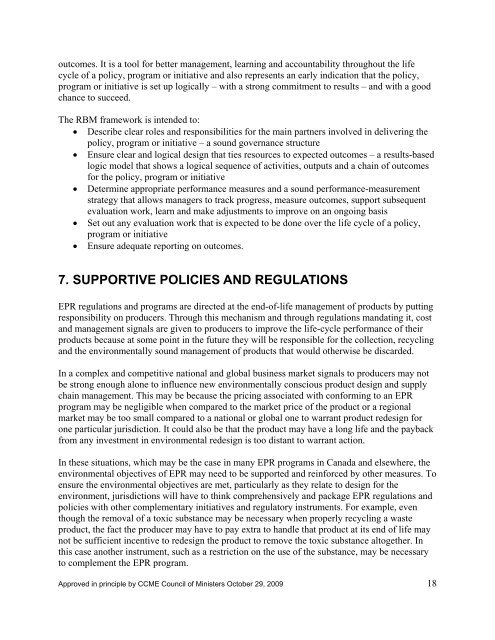Canada-Wide Action Plan for Extended Producer ... - CCME
Canada-Wide Action Plan for Extended Producer ... - CCME
Canada-Wide Action Plan for Extended Producer ... - CCME
Create successful ePaper yourself
Turn your PDF publications into a flip-book with our unique Google optimized e-Paper software.
outcomes. It is a tool <strong>for</strong> better management, learning and accountability throughout the life<br />
cycle of a policy, program or initiative and also represents an early indication that the policy,<br />
program or initiative is set up logically – with a strong commitment to results – and with a good<br />
chance to succeed.<br />
The RBM framework is intended to:<br />
• Describe clear roles and responsibilities <strong>for</strong> the main partners involved in delivering the<br />
policy, program or initiative – a sound governance structure<br />
• Ensure clear and logical design that ties resources to expected outcomes – a results-based<br />
logic model that shows a logical sequence of activities, outputs and a chain of outcomes<br />
<strong>for</strong> the policy, program or initiative<br />
• Determine appropriate per<strong>for</strong>mance measures and a sound per<strong>for</strong>mance-measurement<br />
strategy that allows managers to track progress, measure outcomes, support subsequent<br />
evaluation work, learn and make adjustments to improve on an ongoing basis<br />
• Set out any evaluation work that is expected to be done over the life cycle of a policy,<br />
program or initiative<br />
• Ensure adequate reporting on outcomes.<br />
7. SUPPORTIVE POLICIES AND REGULATIONS<br />
EPR regulations and programs are directed at the end-of-life management of products by putting<br />
responsibility on producers. Through this mechanism and through regulations mandating it, cost<br />
and management signals are given to producers to improve the life-cycle per<strong>for</strong>mance of their<br />
products because at some point in the future they will be responsible <strong>for</strong> the collection, recycling<br />
and the environmentally sound management of products that would otherwise be discarded.<br />
In a complex and competitive national and global business market signals to producers may not<br />
be strong enough alone to influence new environmentally conscious product design and supply<br />
chain management. This may be because the pricing associated with con<strong>for</strong>ming to an EPR<br />
program may be negligible when compared to the market price of the product or a regional<br />
market may be too small compared to a national or global one to warrant product redesign <strong>for</strong><br />
one particular jurisdiction. It could also be that the product may have a long life and the payback<br />
from any investment in environmental redesign is too distant to warrant action.<br />
In these situations, which may be the case in many EPR programs in <strong>Canada</strong> and elsewhere, the<br />
environmental objectives of EPR may need to be supported and rein<strong>for</strong>ced by other measures. To<br />
ensure the environmental objectives are met, particularly as they relate to design <strong>for</strong> the<br />
environment, jurisdictions will have to think comprehensively and package EPR regulations and<br />
policies with other complementary initiatives and regulatory instruments. For example, even<br />
though the removal of a toxic substance may be necessary when properly recycling a waste<br />
product, the fact the producer may have to pay extra to handle that product at its end of life may<br />
not be sufficient incentive to redesign the product to remove the toxic substance altogether. In<br />
this case another instrument, such as a restriction on the use of the substance, may be necessary<br />
to complement the EPR program.<br />
Approved in principle by <strong>CCME</strong> Council of Ministers October 29, 2009 18
















